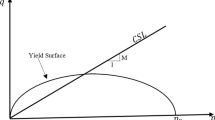Abstract
The performance of several soil constitutive models was evaluated by comparing experimental results and simulated behavior of a medium plasticity clay. Input parameters for the soil constitutive models were obtained from triaxial compression and extension tests on normally and overconsolidated medium plasticity clay. The soil models employed for this study were the Cam Clay, Modified Cam Clay, 3-SKH, and S-CLAY1 models. In order to investigate the influence of some of the input parameters on the performance of the models, sensitivity analyses were also performed. The comparisons demonstrate that the Cam Clay model was able to predict the normally consolidated compressive behavior of medium plasticity clay. Both 3-SKH and Cam Clay models were able to produce acceptable predictions for stress–strain and stress path behavior for overconsolidated compression of the soil. The 3-SKH model did not perform satisfactorily for predicting pore pressure variations, while the Cam Clay model demonstrated fairly acceptable predictions. For the normally consolidated reduced extension test, the Modified Cam Clay and S-CLAY1 models performed better than the Cam Clay and 3-SKH models in predicting the stress–strain curve, pore pressure variations, and stress path.













Similar content being viewed by others
References
Addenbrooke TI, Potts DM, Puzrin AM (1997) The influence of pre-failure soil stiffness on the numerical analysis of tunnel construction. Géotechnique 47(3):693–712
Atkinson J (2007) The mechanics of soils and foundations, 2nd edn. Taylor and Francis, NY., p 442
Baudet BA, Stallebrass SE (2004) A constitutive model for structured clays. Géotechnique 54(4):269–278
Cotecchia F, Chandler RJ (2000) A general framework for the mechanical behavior of clays. Géotechnique 50(4):431–447
Crisp Consortium (1995) CRISP2D examples, CRISP tutorial manual. Crisp Consortium Ltd, London
Grammatikopoulou A (2004) Development, implementation and application of kinematic hardening models for overconsolidated clays, PhD thesis, University of London, London, England
Head KH (1996) Manual of soil laboratory testing, vol 3. Halsted Press, NY, p 1238
Hicher PY, Shao JF (2008) Constitutive modeling of soils and rocks. ISTE Ltd and Wiley, NJ, p 448
Ingram PJ (2000) The application of numerical models to natural stiff clays, Ph.D. thesis, City University, London
Jardine RJ, Symes MJ, Burland JB (1984) The measurement of soil stiffness in triaxial apparatus. Géotechnique 34(3):323–340
Leroueil S, Vaughan PR (1990) The general and congruent effects of structure in natural soils and weak rocks. Géotechnique 41(3):467–488
Liu MD, Carter JP (2002) Structured cam clay model. Canadian Geotechnical J 39(6):1313–1332
Masin D (2004) Laboratory and numerical modeling of natural clays, M.Phil. thesis, City University, London, England
Masin D, Tamagnini C, Viggiani G, Costanzo D (2006) Directional response of a reconstituted fine-grained soil (Part II): Performance of different constitutive models. Int J Numer Anal Meth Geomech 30:1303–1336
Messerklinger S (2006) Non-linearity and small strain behaviour in lacustrine clay, Doctor of science thesis, Eth Zurich University, Zurich, Switzerland
Newell WL (2001) Geology of Kentucky-A text to accompany the geologic map of Kentucky. US Geological survey professional paper 115-H, Online Version 1.0. US Geological survey, Washington
Roscoe KH, Burland JB (1968) On the generalized stress–strain behaviour of ‘wet’ clay, Engineering plasticity. Cambridge University Press, Cambridge, pp 553–609
Schofield A, Wroth CP (1968) Critical state soil mechanics. McGraw-Hill, London
Sloan SW, Randolph MF (1982) Numerical prediction of collapse loads using finite element method. Int J Num Analy Meth Geomech 6(1):47–76
Stallebrass SE (1990) The effect of recent stress history on the deformation of overconsolidated soils, PhD thesis, City University, London, England
Stallebrass SE, Grant RJ, Taylor RN (1996) A finite element study of ground movements measured in centrifuge model tests of tunnels, Geotechnical aspects of underground construction in soft ground. Balkema, Rotterdam
Stallebrass SE, Taylor RN (1997) The development and evaluation of a constitutive model for the prediction of ground movements in overconsolidated clay. Géotechnique 47(2):235–253
Tamagnini C, Masin D, Costanzo D, Viggiani G (2006) An evaluation of different constitutive models to predict the directional response of a reconstituted fine-grain soil. In: Modern trends in geomechanics. Springer Proceedings in Physics, vol. 106, part II, pp. 143–157. doi:10.1007/978-3-540-35724-7_9
Wheeler SJ, Näätänen A, Karstunen M, Lojander M (2003) An anisotropic elastoplastic model for soft clays. Can Geotech J 40:403–418
Author information
Authors and Affiliations
Corresponding author
Rights and permissions
About this article
Cite this article
Bryson, L.S., Salehian, A. Performance of constitutive models in predicting behavior of remolded clay. Acta Geotech. 6, 143–154 (2011). https://doi.org/10.1007/s11440-011-0144-5
Received:
Accepted:
Published:
Issue Date:
DOI: https://doi.org/10.1007/s11440-011-0144-5




